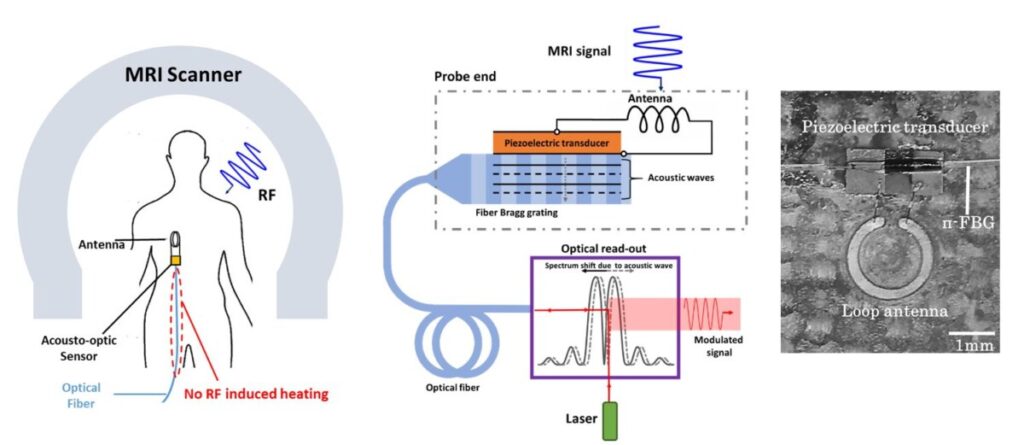Magnetic resonance imaging (MRI) uses powerful radio frequency (RF) fields during imaging. While producing the imaging signals, RF energy is absorbed by the tissue and causes temperature rise. RF induced heating is a significant safety concern during diagnostic imaging especially for patients with implants and pacemaker leads, as these conducting structures can resonate with the RF field and cause local hot spots. Similar issues arise during minimally invasive interventional MRI procedures where markers with conducting lines are used to locate and guide endovascular devices or catheters in the patient’s body. In those applications, markers avoiding RF induced heating and image distortion are needed. Our current efforts are focused on 1) RF dosimetry (SAR measurement) to monitor RF induced heating and 2) MRI marker development for device tracking under MRI.
We have recently developed an acousto-optic sensor platform utilizing fiber Bragg gratings (FBG) and piezoelectric transducers [1]. This sensor is realized on an optical fiber which is immune to the RF field and eliminates the need for conducting lines which are required for traditional MRI markers and dosimetry sensors. Since the acousto-optic sensor does not require external power, power up optoelectronics are not required at the distal end of the sensor enabling low profile interventional devices. The acousto-optic sensor platform offers a simple solution with high performance for both RF induced heating monitoring and interventional device tracking during MRI procedures.
We envision that this sensor platform will decrease MRI scan times, enable optimization of scan parameters for individual patients as well as imaging of patients with active implants, enable further development and clinical translation of endovascular MRI guided interventions.
This project is currently funded by NIBIB and is performed in collaboration with Prof. Ozgur Kocaturk at Bogazici University, Turkey, Prof. John Oshinski at Emory/GT and Dr. Robert Lederman at NHLBI.

The acousto-optic sensor enables RF safety monitoring and device tracking while eliminating RF induced heating by replacing the conductive cable with optical fiber. A micro-antenna collects the local MRI signal drives a piezoelectric transducer to generate acoustic waves. Then, a fiber Bragg grating picks up the acoustic waves and converts them into an optical signal, which contains the information of deposited RF power or marker location.
Project funding: NIH
Associated students: Yusuf Yaras
[1] Y. S. Yaras et al., “Acousto-Optic Catheter Tracking Sensor for Interventional MRI Procedures,” IEEE Trans. Biomed. Eng., vol. 66, no. 4, pp. 1148–1154, 2019.
Links:
Ozgur Kocaturk: https://bme.boun.edu.tr/node/1788/
John Oshinski: https://www.cores.emory.edu/csic/about/leadership%20/John%20Oshinski.html
Robert Lederman: https://irp.nih.gov/pi/robert-lederman